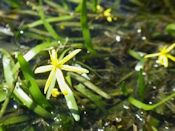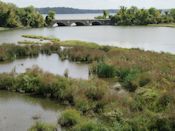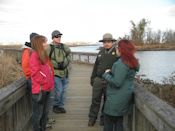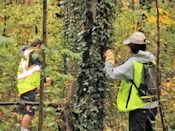Waterfowl numbers in Dyke Marsh, Hunting Creek and along the Potomac River multiply in the winter and many people love to study and identify them. Waterfowl are ducks, geese and swans, birds that require water bodies or aquatic habitats to survive. These birds have waterproof feathers, webbed feet and broad bills.
Submerged aquatic vegetation (SAV), native and non-native, is increasing in the Potomac River and helps improve water quality, reported the Interstate Commission on the Potomac River Basin (ICPRB), citing the September 13, 2017, presentation to the Friends of Dyke Marsh by Dr. Nancy Rybicki, U.S. Geological Survey (see below).
Dr. Kim de Mutsert, Assistant Professor, George Mason University (GMU), gave a presentation to the Friends of Dyke Marsh, the Potomac Riverkeeper and the Northern Virginia Conservation Trust on November 15, 2017, examining the health of Hunting Creek, a tributary of the Potomac River just north of Dyke Marsh. This stream receives treated wastewater from the Alexandria Renew Enterprises wastewater treatment plant and untreated stormwater runoff. Since 2013, Alexandria Renew has funded GMU’s Potomac Environmental Research and Education Center to monitor water quality and the biological communities of Hunting Creek.
Three Mount Vernon High School teachers visited Dyke Marsh on November 19, 2017, doing “advance work” to prepare to bring MVHS environmental science and biology students to Dyke Marsh soon. Linda Townley, Victoria Correa and Amy Niss explored the flora, fauna and habitats of the preserve with NPS ranger Alex Parody, FODMers Ed Eder, Ned Stone and Glenda Booth, and discussed plans for students to visit and learn.
Fifteen enthusiastic volunteers helped rescue trees from invasive plants on a drizzly Sunday morning, November 5, 2017, working in the marsh along the bicycle path across from Tulane Drive. They tackled English ivy, porcelainberry, clematis/Virgin’s bower, honeysuckle and bittersweet, most of which can threaten the survival of many trees and shrubs. The trees and shrubs targeted included oaks, hollies, sassafrases, hornbeams, blackhaws, viburnums, spicebushes and strawberry bushes.






